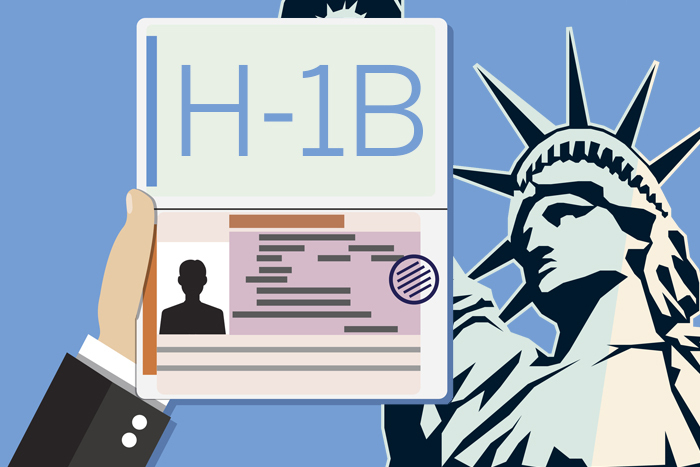The H-1B visa allows US employers to hire foreign professionals to work in the US when qualified Americans cannot be found. Here are the requirements, processes, and latest changes to this program.

The H-1B visa program is probably the most well-known US federal employment visas, and arguably the most controversial. Businesses say it’s too restrictive. Labor organizations complain that it displaces US workers and lowers their wages. Some politicians use it to appeal to their base with scant ability to fix the process to the benefit of all. But the truth lies somewhere in between these extremes.
The following overview of the H-1B visa is accurate as of the publication date. Be aware that the rules and internal business processes of the H-1B visa are complex. Either could be changed by legislation, executive order, or internal process reviews. For the latest rules, consult the Department of Labor (DoL), US Citizenship and Immigration Services (USCIS), or a legal firm specializing in immigration.
What is the H-1B visa?
The H-1B visa allows US employers to hire foreign national professionals to work in the US when qualified Americans cannot be found. The H-1B visa holder can work only for the sponsoring employer or the visa will be revoked. The visa was created in 1990 when Congress expanded the 1965 Immigration and Nationality Act and is not a direct path to citizenship.
According to the Department of Labor website, “The intent of the H-1B provisions is to help employers who cannot otherwise obtain needed business skills and abilities from the US workforce by authorizing the temporary employment of qualified individuals who are not otherwise authorized to work in the United States.”
H-1B visa requirements
To be eligible for an H-1B visa, professionals from other countries must work in a “specialty occupation” that requires “theoretical and practical application” of a unique body of knowledge and hold at least a bachelor’s degree, or equivalent, in the discipline. IT, engineering, medicine, math, law, accounting, and other difficult-to-master occupations are eligible for H-1B visas.
H-1B visa process
To obtain an H-1B visa, an employer must complete the following steps:
- File a Labor Condition Application (Form 9035E/ 9035) with the Department of Labor. The employer demonstrates adherence to the H-1B, H-1B1, or E-3 program requirements. The employer must attest that qualified Americans are not available and that wages to be paid are at least equal to the prevailing wage and to wages paid to others in similar positions within the company.
- Following approval of the Labor Condition Report, the employer must file a Petition for a Nonimmigrant Worker (Form I-129) with the US Citizenship and Immigration Services (USCIS), along with supporting documentation and payment, through an online portal. Employers must provide their legal company name, company business, EIN, and address, as well as the authorized representative/signatory of the company’s full name, title, phone number, and address. Companies must then add information for each “beneficiary,” referring to potential H-1B visa holders the company wants to sponsor. USCIS asks for the beneficiary’s legal name, male/female gender (only options available), date of birth, country of birth, country of citizenship, passport number, and whether they currently hold a US master’s degree. The fee for each petition filed differs based on a variety of factors, including employer status, size, and extent of H-1B worker employment, and companies can only submit one unique petition per beneficiary. An additional premium processing fee of $2,805 can be applied to expedite the process to within 15 business days. Specific information on fees is available from USCIS, by searching on I-129 here. If selected, companies have 90 days to then complete and submit their workers’ full applications.
- After the Petition for a Nonimmigrant Worker is approved, the named worker can apply for the actual H-1B visa. The approved visa will allow the individual to enter the US. If the individual is already in the US legally, the actual H-1B visa is required if the employee wants to leave and reenter the US.
H-1B visa cost and fees
As of September 21, 2025, employers are now required to pay a one-time fee of $100,000 for every new H-1B visa petition that they file. Previously, depending on the size of the company, the fee was around $2,000 to $5,000 per petition.
There has been some confusion around the new fee — when it was initially announced, it wasn’t clear that the new fee would not apply to current H-1B visa holders. As a result, many visa holders in America cancelled plans to return to or vacation in other countries, fearing that they would not be able to afford to return with the new fees. It was then clarified by the Trump administration that this new fee will only apply to new applicants moving forward.
Despite the clarification, the announcement will still have large ramifications on the tech industry. The biggest sponsor of H-1B workers in 2025 was Amazon, with over 10,000 employees holding the visa. Other top H-1B employers include Microsoft, Meta, Apple, Google, Cognizant Technology Solutions, JPMorgan Chase, and Walmart, according to the American Immigration Council. These companies will need to make shifts in their hiring strategies to account for the increased cost of filing H-1B petitions for new foreign talent.
H-1B visa quotas and lottery
The H-1B visa lottery is limited to 65,000 new statuses or visas for each fiscal year, with an additional 20,000 spaces available for petitions filed for beneficiaries holding a master’s degree or higher from a US institution that qualifies them as exempt from the original cap. Only new H-1B applicants are required to go through the lottery system — and petitions are selected at random to be evaluated. Foreign workers who are still within the three-year limit of their H-1B visa are free to transfer to another employer without being subjected to the lottery pool once their new employer files a nonfrivolous H-1B petition with the USCIS. However, for foreign workers who have exceeded the six-year limit on the H-1B visa may be required to re-enter the lottery system if they plan to return to work in the US after the one-year waiting period.
H-1B cap-exempt workers include those who have been previously granted an H-1B status and are still within the six-year period. Exemptions can also apply to workers in higher education, nonprofit organizations associated with a higher education institution, or nonprofit research or government organizations. You may also qualify for a cap-extension through your employer if you currently live in a country outside the US but have been “in status” within the past six years, without reaching your maximum duration of stay.
The H-1B visa lottery was reformed for FY 2025 to streamline the process and reduce redundancies in filing by requiring beneficiaries to use one unique identifier, such as a passport or travel document number. Previously, beneficiaries could submit multiple registrations for the same candidate, weighing the lottery in favor of certain candidates. Now, only one petition can be filed per candidate, even if multiple employers are attempting to hire that worker. If that candidate gets selected, employers will be notified, and then they can proceed with filing an H-1B petition and the beneficiary will choose which job offer they want to accept.
In addition, the USCIS states that individuals with H-1B visas working in the Commonwealth of the Northern Mariana Islands (CNMI) and Guam may not be counted in the H-1B cap. Since the rules can change frequently, consult the Department of Labor for the most recent updates.
Individuals must have a relevant degree from a public or not-for-profit university located in the United States. The school must be properly accredited by a formally recognized accrediting organization such as the Accrediting Council for Independent Colleges and Schools or the Accrediting Council for Continuing Education and Training. For more information visit the USCIS website.
Proposed lottery changes
The Trump administration recently announced a proposal to rework the H-1B lottery system to prioritize higher paid, more senior, and higher-skilled foreign employees. This “weighted selection process” would take effect whenever annual demand for visas exceeds the 85,000 limit — something that has happened every year for the past decade. The current lottery system is random, assigning H-1B visa applications blindly in the pool of candidates.
The newly proposed system would categorize beneficiaries into four different wage groups, submitting the highest paid workers four times more than the lowest wage category, which would only be entered into the selection pool once. Speaking on the proposed changes, US President Donald Trump said they are intended to help recruit workers with “additive, high-skilled functions,” noting that the current system has been “deliberately exploited to replace, rather than supplement, American workers with lower-paid, lower-skilled labor.”
However, there are criticisms of this proposal, including that a weighted system based on salary doesn’t necessarily correlate with skill or expertise. It’s likely that these propose changes will be challenged in court — the Trump administration attempted to impose similar lottery changes in 2021, but comments made during the ruling indicated that such a move violated US immigration law, according to Forbes.
H-1B visa impacts on US workers
Much attention has been drawn in the past decade to numerous instances of H-1B abuse. Firms that have twisted the intent of the program to hire inexperienced workers at lower pay, outsourcers that have flooded the applicant pool, IT workers needing to train H-1B replacements — incidents such as these have only fueled controversy around the H-1B visa’s impact on US workers.
Contrary to popular belief, however, foreign national talent, including those working in the US under the H-1B visa program, has a net positive impact on the labor market, according to the American Immigration Council. Skilled immigrants’ contributions help create jobs and opportunities for expansion through innovation, and despite suggestions to the contrary, H-1B workers do not drive down wages of native-born workers; in fact, some studies show a positive impact on wages overall.
From 2009 to 2011, wage growth for US-born workers with at least a bachelor’s degree was nominal, but wage growth for workers in occupations with large numbers of H-1B petitions was substantially higher. For example, in the Computer Systems Design and Related Services category, there has been a 5.5% wage growth since 1990 and a 7% wage growth since 2009. In comparison, wage growth across all industries has been 0.8% since 1990 and 1.6% since 2009.
Despite such evidence, politicians have introduced legislation to protect Americans from being displaced by H-1B visa holders. In April 2017 the DoL increased coordination with Homeland Security, the Department of Justice and other government agencies to investigate possible discrimination. In October 2018 the DoL updated the Labor Condition Application (Form ETA-9035) and the worker complaint form (Form WH-4) to increase transparency.
These changes intend to improve H-1B compliance and promote greater transparency regarding the employment of foreign national workers, according to DoL. The Labor Condition Application form now requires employers to provide more detailed information about H-1B worker employment conditions, including:
- Disclosing all places of employment for H-1B workers, including periods of short duration
- Providing the estimated number of H-1B workers at each place of intended employment
- Requiring clear identification of secondary entities who are using H-1B workers
- Requiring H-1B dependent employers who claim an exemption based on education, such as a master’s degree, to provide documentation of the degree
Revisions to the worker complaint form included additional data fields designed to better describe the nature of an alleged program violation. Finally, the USCIS has established an email address for individuals to submit ideas for improvement or tips regarding potential violations.
H-1B visa duration
According to USCIS, foreign workers with H-1B visas can stay in the US for up to six years, as an H-1B visa is initially valid for three years and can be extended for another three years. When a worker’s H-1B expires, the worker must either leave the US, obtain an extension of the visa through the American Competitiveness in the Twenty-First Century Act (AC21), or apply for a different visa status. If the worker simply stays in the US past the expiration of the H-1B status, the worker loses legal status in the US and can be removed (deported).
Under AC21, two groups of H-1B visa holders can extend their visa past the six-year maximum, according to NOLO.com, an online legal information service that connects people with available immigration attorneys in their geographic area: workers who are the beneficiary of an approved immigrant worker petition (I-140) and cannot yet file a green card application because the worker’s “priority date” is not current, and workers whose US employers filed a Labor Certification application or an I-140 petition on the worker’s behalf prior to the beginning of the sixth year in H-1B status.
Due to backlogs in priority dates for some categories, workers could potentially be in H-1B status for many years beyond the six-year maximum waiting for their priority date to become current.
H-1B denial rates
Rates of H-1B visa denials have risen sharply over the past few years, according to Forbes, and there’s been a substantial increase in Requests for Evidence (RFE), which requires sponsoring employers to submit further information about their sponsored employee(s) or to fill in gaps or omissions in the visa application.
Denial rates for H-1B petitions rose from 6% in 2015 to 24% through Q3 2019 for new H-1B petitions for initial employment, according to a National Foundation for American Policy (NFAP) analysis. The denial rate for H-1B petitions for continuing employment (for existing employees) remained relatively stable (and high) at 10% in Q2 2019 and 9% in Q3 2019, according to the NFAP analysis.
As of Q2 2019, the RFE percentage of completed H-1B visa petitions was 48% compared to an RFE percentage in 2015 of 22%, according to USCIS data compiled by Envoy Global.
How much are H-1B visa holders paid?
The current minimum salary for H-1B visa holders is $60,000 per year, unchanged since the program began in 1989. The program does mandate that employers pay H-1B holders the “prevailing wage” for their work in the area where they are hired. That means in technology some H-1B workers can earn upwards of $100,000 annually; however, a recent report showed that between 2010 and 2016, the average salary for H-1B visa holders working in technology was $80,600.
In January 2017 California Representative Zoe Lofgren introduced the High-Skilled Integrity and Fairness Act of 2017. This bill prioritizes allocation of H-1B visas to companies that agree to pay H-1B visa holders 200% of the current minimum salary, $130,000. In addition, the bill reserves 20% of H-1B visas for businesses with less than 51 full-time employees, including parent companies, subsidiaries, or other affiliated entities. The bill was referred to the Subcommittee on Immigration and Border Security, but nothing further has happened with it.
In January 2017 Congressman Darrell Issa (R-Calif.) supported by Congressman Scott Peters (D-Calif.) introduced H.R. 170, the Protect and Grow American Jobs Act. This bill would increase the attestation requirements of H-1B employees to $100,000. It too is awaiting action by the Subcommittee on Immigration and Border Security, and has languished in Congress.
Path to permanent US residence
The holder of an H-1B visa can have “dual intent.” Although the H-1B is a non-immigrant visa, the holder can apply for a green card at the same time. Because the time required to obtain a green card has lengthened in recent years, the H-1B offers a way for individuals to work in the US while seeking to become permanent residents.
H-1B visa revocation
The USCIS can revoke an H-1B visa. While it is not common, it does happen if the sponsoring employer is going out of business or cancels their original request. After the H-1B visa has been granted, employers can terminate employees but must comply with the terms of any employment agreement and follow federal, state, and local employment law.
Visas similar to H-1B
A number of visas similar to H-1B exist. The H-1B1 visa and the E-3 visa, for example, allow individuals from Chile and Singapore and from Australia, respectively, to work in the US under essentially the same requirements as the H-1B visa. Each year, 1,400 workers from Chile and 5,400 workers from Singapore may obtain H-1B1 visas. The E-3 visa allows 10,500 Australians to work in the US.
The Temporary Business visa allows holders to remain in the US for six months to cut a business deal, attend a conference or complete training. The F-1 visa is for international students studying at US colleges and universities, and the Optional Practical Training (OPT) program allows F-1 visa holder students to remain in the US for 12 months after graduating. Those with STEM degrees from Student and Exchange Visitor Program (SEVP)-certified and accredited U.S. colleges and universities are eligible for an additional 24-month OPT extension. To read more about STEM-OPT, see “Hiring STEM-OPT Employees: What businesses need to know.”
H-1B visa dependents
Spouses and unmarried children under 21 can get an H-4 visa to enter the US with an H-1B visa holder. The H-4 visa holder can stay in the US as long as the H-1B is in effect. An individual with an H-4 visa can attend school, get a driver’s license, and open a bank account. As of May 26, 2015, certain H-4 visa holders can become “lawful permanent residents” (LPR) and become eligible to work.
In August 2020, the Trump administration passed an executive order that revoked H-4 visa opportunities, stripping away work authorization from spouses of H-1B visa holders. The move left families, who were often living in high cost of living areas such as Silicon Valley, dependent on a single income. However, President Biden overturned the order on his first day in office, allowing dependents of H-1B visa holders to continue working in the US. Biden’s proposed immigration reform also included measures to ensure that those already holding H-1B visas will gain permanent work authorization for dependents and that their children will not be aged out of the system. With Trump back in office, he has not moved to strip away H-4 visa opportunities, but immigration experts warn it could be on the horizon.
H-1B visa holder taxation
H-1B visa holders have to obtain an Individual Taxpayer Identification Number and pay US taxes, Social Security, and Medicare. However, the rules can get very complicated depending on whether the H-1B visa holder is categorized as a resident alien or a non-resident alien. At a summary level, the IRS uses the “substantial presence test” to classify each H-1B holder.
Substantial presence is a function of the number of days an individual has spent in the US during the current tax year along with the prior three tax years. Individuals who fall above the threshold are deemed resident aliens and are taxed on all income, including non-US income. Individuals who fall below the threshold are considered non-resident aliens and are only taxed on US income. There are many rules and exemptions, so it’s recommended that H-1B visa holders consult a tax specialist.








